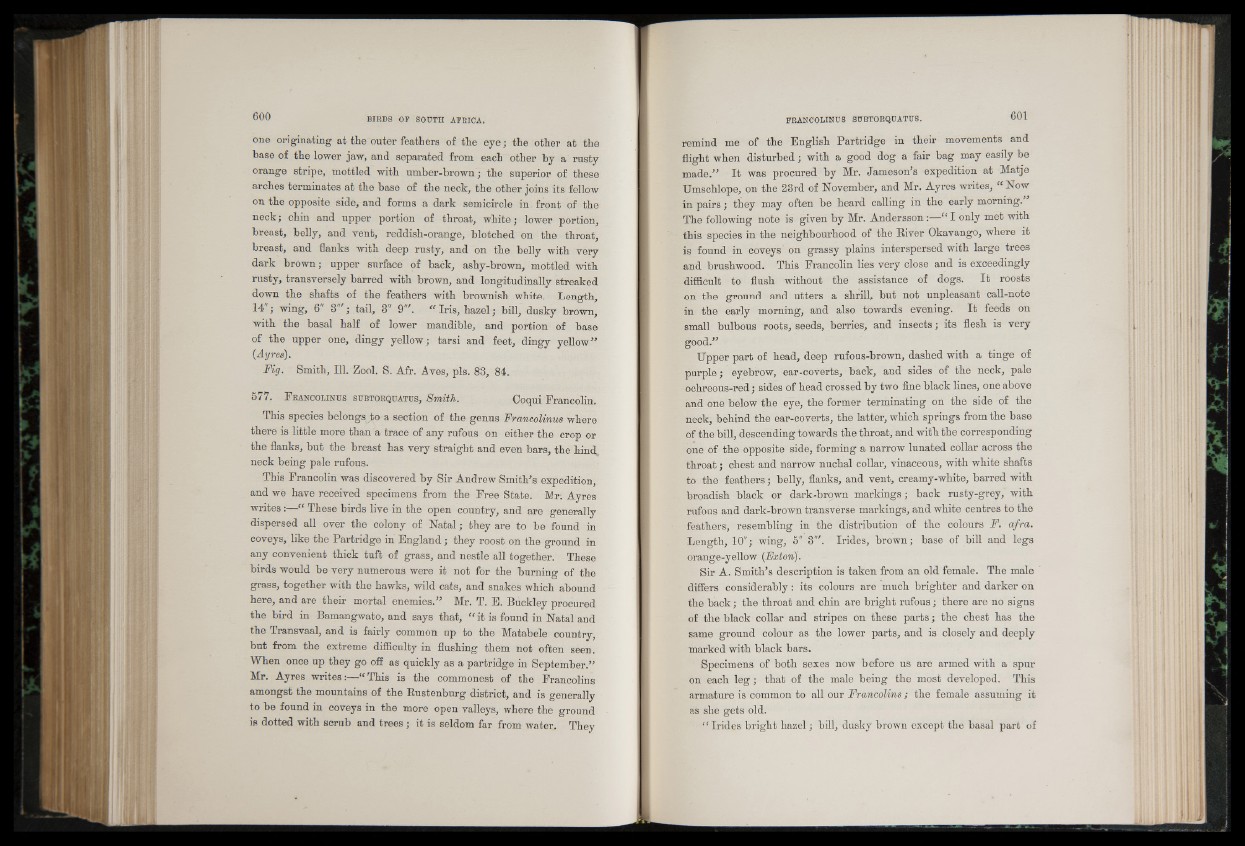
one originating at the outer feathers of the eye; the other at the
base of the lower jaw, and separated from each other by a rusty
orange stripe, mottled with umber-brown; the superior of these
arches terminates at the base of the neck, the other joins its fellow
on the opposite side, and forms a dark semicircle in. front of the
neck; chin and upper portion of throat, white; lower portion,
breast, belly, and vent, reddish-orange, blotched on the throat,
breast, and flanks with deep rusty, and on the belly with very
dark brown; upper surface of back, ashy-brown, mottled with
rusty, transversely barred with brown, and longitudinally streaked
down the shafts of the feathers with brownish white. Length,
14 ; wing, 6 3 ; tail, 3' 9 ". “ Iris, hazel; bill, dusky brown,
with the basal half of lower mandible, and portion of base
of the upper one, dingy yellow; tarsi and feet, dingy yellow”
(Ayres).
Fig. Smith, 111. Zool. S. Afr. Aves, pis. 83, 84.
577. F r a n c o l in u s s u b t o r q u a t u s , Smith. Coqui Francolin.
This species belongs to a section of the genus Francolinus where
there is little more than a trace of any rufous on either the crop or
the flanks, but the breast has very straight and even bars, the hind,
neck being pale rufous.
This Francolin was discovered by Sir Andrew Smith's expedition,
and we have received specimens from the Free State. Mr. Ayres
writes :—“ These birds live in the open country, and are generally
dispersed all over the colony of Natal; they are to be found in
coveys, like the Partridge in England ; they roost on the ground in
any convenient thick tuft of grass, and nestle all together. These
birds would be very numerous were it not for the burning of the
grass, together with the hawks, wild cats, and snakes which abound
here, and are their mortal enemies.” Mr. T. E. Buckley procured
the bird in Bamangwato, and says that, “ it is found in Natal and
the Transvaal, and is fairly common up to the Matabele country,
but from the extreme difficulty in flushing them not often seen.
When once up they go off as quickly as a partridge in September.”
Mr. Ayres writes:—“ This is the commonest of the Francolins
amongst the mountains of the Rustenburg district, and is generally
to be found in coveys in the more open valleys, where the ground
is dotted with scrub and trees; it is seldom far from water. They
remind me of the English Partridge in their movements and
flight when disturbed; with a good dog a fair bag may easily be
made.” It was procured by Mr. Jameson's expedition at Matje
Umschlope, on the 23rd of November, and Mr. Ayres writes, “ Now
in pairs; they may often be heard calling in the early morning.
The following note is given by Mr. Amdersson: “ I only met with
this species in the neighbourhood of the River Okavango, where it
is found in coveys on grassy plains interspersed with large trees
and brushwood. This Francolin lies very close and is exceedingly
difficult to flush without the assistance of dogs. I t roosts
on the ground and utters a shrill, but not unpleasant call-note
in the early morning, and also towards evening. It feeds on
small bulbous roots, seeds, berries, and insects; its flesh is very
good.”
Upper part of head, deep rufous-brown, dashed with a tinge of
purple; eyebrow, ear-coverts, back, and sides of the neck, pale
ochreous-red; sides of head crossed by two fine black lines, one above
and one below the eye, the former terminating on the side of the
neck, behind the ear-coverts, the latter, which springs from the base
of the bill, descending towards the throat, and with the corresponding
one of the opposite side, forming a narrow lunated collar across the
throat; chest and narrow nuchal collar, vinaceous, with white shafts
to the feathers; belly, flanks, and vent, creamy-white, barred with
broadish black or dark-brown markings; back rusty-grey, with
rufous and dark-brown transverse markings, and white centres to the
feathers, resembling in the distribution of the colours F. afr a.
Length, 10"; wing, 5" 3'". Irides, brown; base of bill and legs
orange-yellow (Exton).
Sir A. Smith's description is taken from an old female. The male
differs considerably: its colours are much brighter and darker on
the back; the throat and chin are bright rufous; there are no signs
of the black collar and stripes on these parts; the chest has the
same ground colour as the lower parts, and is closely and deeply
marked with black bars.
Specimens of both sexes now before us are armed with a spur
on each le g ; that of the male being the most developed. This
armature is common to all our Francolins ; the female assuming it
as she gets old.
“ Irides bright hazel; bill, dusky brown except the basal part of